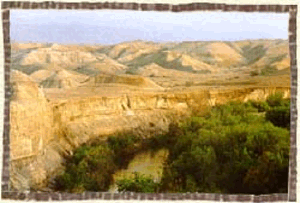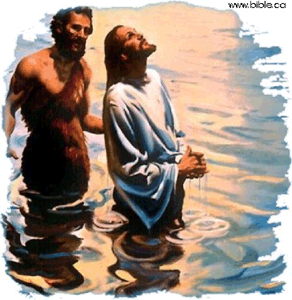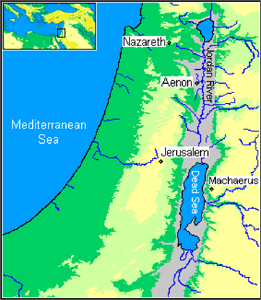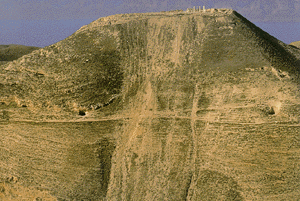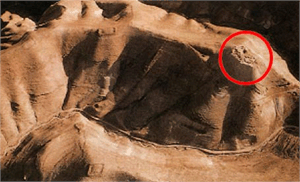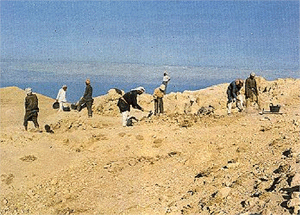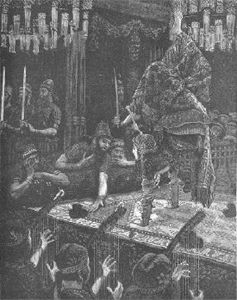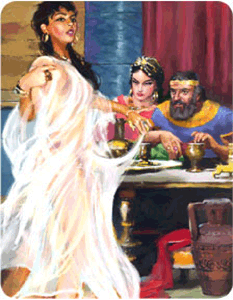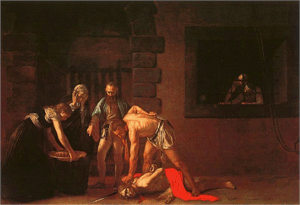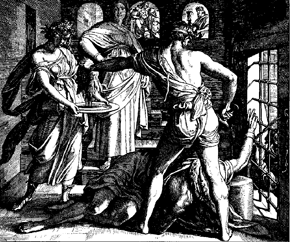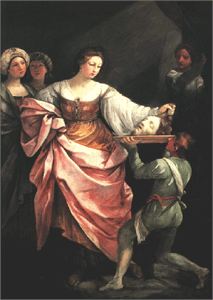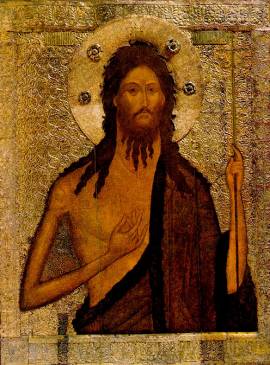
Christmas
Easter
Pentcoest
All Saints
Christ The King
Confirmation
Palm/Passion
Reformation
Stewardship
Books of the Bible
Lenten Series
Christmas Dramas
Videos
Series A - Matthew
Series B - Mark
Series C - Luke
Series D - Other
To contact
Edward F. Markquart
info@sfs.com

Series B Pentecost 6B Mark 6:14-29 (The preacher can create powerpoints of the images within this sermon and show them during the sermon.) Some days are shockers. Bombshells. Pure disasters. Friday, November 22, 1963. Dallas, Texas. 12:30 PM. A presidential motorcade was working its way through Dallas. Several bullet shots rang out and one bullet pieced the skull of President John Fitzgerald Kennedy. A great American leader was assassinated. A nation was numbed. That day was a disaster. Other assassination days also are embedded in our collective memory. Those days were also shockers, bombshells, and pure disasters. Through our history books and American folklore, we recall the assassination of President Abraham Lincoln in the Ford Theater on April 15th, 1865. Honest Abe, the rail splitter and Great Emancipator of blacks, was shot in the back of the head while in his box in the balcony by John Wilkes Booth. Booth jumped to the stage and shouted in Latin “Sic semper tyrannis” which means, “Thus always to tyrants.” President Lincoln, perhaps the greatest of all presidents of the United States, was the first president to be assassinated. Yes, in the history of the world, great men are sometimes killed because they stand up for what is right. And the day that they are killed, the mountains seem to shake, the trees tremble, the sun and the moon darken. It is a black day for the nation. That day is a shocker, a bombshell, a pure disaster for the country. Such it was the day that John the Baptist was killed. His head chopped by King Herod. John the Baptist was the first authentic voice of God in Israel for four hundred years. People flocked out to the Jordan River to hear John preach. People revered the Baptist. Honored him. Venerated him. Held him up in highest esteem. But one day he was brutally murdered, and the nation was shocked, stunned, and staggered. The story for today is so graphic, so terrible, so vivid in its detail from the Bible. This same story is also told by a Jewish historian by the name of Josephus. He was a historian and advisor to three Roman emperors and his books were widely read for centuries. He was sympathetic to John the Baptist, perhaps because Josephus himself spent three years as a youth, from age sixteen to nineteen, living a life of an ascetic in the desert. The New Testament story of John the Baptist is the only New Testament story that can be examined through secular history in order to gain further information and insights. The story of John the Baptist is found in both the New Testament and the secular history of that time. Today, let us simply focus on the tragic beheading of John the Baptist and what it meant for Jesus, for the first Christians, and for us today. Let’s begin. The story of John the Baptist has been clearly retold in paintings and pictures of his life. Today, let’s look at several of these pictures that tell the story of the Baptist. John’s story begins with his birth. We hear the story at Christmas time how John the Baptist was born to Zechariah and Elizabeth. Zechariah was an old priest in the temple. He came out of the temple, couldn’t speak, and finally after the child was born, he blurted out, “His name shall be John.” . http://www.guggenheim.org/exhibitions/past
We don’t know what happened to John the Baptist in his youth but many of us think that he grew up in the Qumran community, the Dead Sea scroll community, out there in the desert caves near the Dead Sea. He learned about baptism and daily washing out there in that Dead Sea scroll community. You can see such caves in the picture below. http://www.padfield.com/israel/Miscellaneous/images/Cave%204%20at%20Qumran.jpg
John the Baptist was baptizing near the village of Bethany out in the wilderness. Thousands of people would come from the capital city of Jerusalem to hear him preach. Next, you can see a picture of the waters of the Jordan River flowing through the wilderness where he preached to masses of people. http://holysites.com/riverjordan.htm
While in this wilderness area, Jesus came to be baptized him. Several of Jesus’ first disciples had been disciples of John the Baptist. We see a painting of Jesus being baptized by John. His baptism was the beginning event in Jesus’ adult ministry. A voice from heaven declared Jesus to be the Son of God. http://www.jesus-is-savior.com/False%20Religions/Roman%20Catholicism/baptism-of-jesus.jpg
The next time we meet John the Baptist is the day of his execution, the gospel lesson for today. John the Baptist, according to the Jewish historian Josephus, was executed at the prison called Machereus. Find Macheraeus on the map below. http://www.lifeofchrist.com/history/maps/johnmap.asp
This map shows where John the Baptist lived and ministered. Notice the location of the Dead Sea and remember that the Dead Sea Scrolls were found buried in the cliffs overlooking the Dead Sea. Nearby the caves was the ancient fortress of Machaerus. Machaerus was the name of the fortress where John the Baptist was beheaded in the gospel lesson for today. We need to see the site of the castle in which John the Baptist was imprisoned. The fortress of Machaerus was located on the top of this tall hill and had a panoramic view of the Dead Sea and Palestine. Of course, as with nearly all other archeological sites, Machaerus would have worn down through the centuries and been covered with layers of dirt and debris. The first archeological investigations of the site began in 1968. http://www.geocities.com/Jordan_jubilee2000/Machaerus.html
With that introduction, let’s look at the gospel lesson for today about John the Baptist and his death. Please turn to your bulletin. 14 King Herod The Gospel of Mark calls Herod a king but the Gospel of Luke calls him a tetrarch. When Herod the Great died in the year 4 BCE, he divided his kingdom among his sons. Herod the Tetrarch was one of those sons. Tetrarch means four or the ruler of one of the four parts. He was also known as Herod Antipas. He ruled Galilee and Peraea. We learn about this Herod Antipas from the Bible but also from Josephus in his book, THE ANTIQUITY OF THE JEWS. This King Herod, the Tetrarch, ruled for forty years. We meet this King Herod later in the story on Good Friday when Jesus was brought before him. heard of it, for Jesus' name had become known. King Herod heard of “it.” What is “it?” The successful mission of the twelve disciples who had gone out two by two, preached the gospel, and healed the sick. The “it” is the fame of Jesus who had become well known. The previous verses in Mark 6 are about the commissioning of the twelve disciples and sending them out two by two. The disciples were successful in their mission. The question was: “Who is this Jesus, whose movement is starting to sweep the land?” Some said, “John the Baptist raised from the dead.” Some were saying, "John the baptizer has been raised from the dead; and for this reason these powers are at work in him." These words tell us that John the Baptist had already been killed. Jesus was thought to be the reincarnation of John the Baptist and this accounted for the powers that were working through him. That was the rumor floating around the land. 15 But others said, "It is Elijah." Jesus was thought to be Elijah re-incarnated. And others said, "It is a prophet, like one of the prophets of old." Yes, Jesus was thought to be one of the mighty prophets from the Old Testament years. 16 But when Herod heard of it, he said, "John, whom I beheaded, has been raised." Herod was convinced that Jesus was none other than John the Baptist whom Herod had beheaded. Of the choices available to him, Herod thought that Jesus was not a re-incarnated Elijah nor another prophet of the Old Testament. Herod was convinced that Jesus was none other than John the Baptist raised from the dead. In other words, it appears that Herod was feeling guilty about his execution of John the Baptist and that the Baptist was coming back to haunt him in the person of Jesus. The event of John’s beheading is recorded both in our gospels and in THE ANTIQUTIES by Josephus. 17 For Herod himself had sent men who arrested John, bound him, and put him in prison on account of Herodias, his brother Philip's wife, because Herod had married her. In other words, we hear that Herod had illicitly married his brother’s wife. That marriage was morally wrong. John criticized Herod for this sinful action. We hear a similar story from Josephus. A prophet is one who speaks those in power. A prophet usually gets into trouble for criticizing the governing authorities. Those governing authorities often imprison or kill that prophet in order to silence him. Then the prophet becomes a martyr, one who dies for the faith. A prophet is a truth-teller and often governing authorities don’t like a truth-teller telling the truth about them. The prophet is a whistle-blower and John the Baptist blew the whistle about Herod’s marriage to Heriodius. The prophet shouted, “Foul.” Herod and Herodius preferred that John the Baptist would have kept his mouth shut, so the two of them could continue their lives in wedded bliss. 18 For John had been telling Herod, "It is not lawful for you to have your brother's wife." John did not mince words. He called a spade a spade. Prophets always do. Martyrs always do. It appears that John spoke directly to Herod. We do not know how John came to be in the presence of Herod, but the text suggests that John spoke directly to Herod. One of the purposes of the prophets is to speak the Word of the Lord to the governing authorities. The prophet Nathan had spoken similar condemning words to King David about Bathsheba. John the Baptist told the truth to Herod that he had illicitly married his brother’s wife. Herod did not like that John was so bold and brash with the truth. Throughout the centuries, prophets have been truth-tellers to their kings. In more recent times, you may remember Robert Bolt’s play, A MAN FOR ALL SEASONS, and the story of Sir Thomas More confronting the king about his impending divorce. Sir Thomas More was executed for speaking out against the king’s moral choices. I remember seeing that play at the end of the Viet Nam War, and the audience erupted with a standing ovation. It was a standing ovation like I had never seen before. Sir Thomas More was presented as a figure who stood by his convictions and criticisms of the king. There are times in history when people need to stand by their convictions and against the moral choices of the political leadership of the day. Sir Thomas More became a symbol of the anti-war movement during the Viet Nam era. He was a man who stood up against an immoral choice by the king … and paid the price for it with his neck. 19 And Herodias had a grudge against him, and wanted to kill him. But she could not, The motive for the evil deed was to be found within the heart Herodias. Herodius was vindictive. She, too, must have heard the piercing criticisms by John the Baptist about her marriage to Herod, and she was simmering inside with rage against the Baptist. 20 for Herod feared John, knowing that he was a righteous and holy man, and he protected him. Herod respected John, knowing that the Baptist was a righteous and holy man. Herodius could not have John executed because Herod was mesmerized by the integrity and moral righteousness of John and held him in high esteem. We recall that Simon Peter, the original story teller, thought that John the Baptist was a righteous and holy man. In what way did Herod protect John? Maybe from the wrath of Herodius as long as he could? When he heard him, he was greatly perplexed; and yet he liked to listen to him. In other words, it seems that Herod found John and John’s message intriguing. It seems that Herod was positive and receptive to John’s words and wisdom. Simon Peter via the Gospel of Mark tells us that Herold like to listen to the Baptist. 21 But an opportunity came when Herod on his birthday gave a banquet for his courtiers and officers and for the leaders of Galilee. Readers from all centuries can imagine the scene. Simon Peter via John Mark (the Gospel of Mark) gives us so many colorful details. It seems that Herodius was looking for an opportunity to “get” John. 22 When his daughter Herodias (named Salome according to Josephus.) When I asked my Bible class if anyone knew the name of Herodias’ daughter, several members volunteered her name. Salome! Yet the name of Salome is not mentioned in the Biblical text. People knew the name of Salome, Herodias’ daughter. Why? Because Josephus’ naming of Salome had become part of our folk knowledge of this New Testament story. This was a step-daughter from Herodius’ previous marriage, not a biological daughter from a union between Herod and Herodius. came in and danced, she pleased Herod and his guests; and the king said to the girl, "Ask me for whatever you wish, and I will give it." Students of the Old Testament think of the parallels of this story to Ester and her dancing before the king who also promised to give her half of the kingdom. We can imagine her dancing before the king. http://home.halden.net/vibeke/tissot/212.jpg
In our modern minds, we sometimes think that she dance a seductive dance, even though the text does not say that. See the painting below. http://www.bibleuniversity.com/images/CourseID1/lesson19-00.jpg
23 And he solemnly swore to her, "Whatever you ask me, I will give you, even half of my kingdom." Obviously, Herod was “taken” with the young woman and her dance. What a foolish and impetuous comment, revealing the character of Herod and the Herod family before him. Or perhaps Herod was playfully exaggerating with the young girl when he made his promise. It is difficult to think that Herod was actually offering half his kingdom in appreciation for a dance. His words have an air of being puffed up bravado in front of his friends and perhaps were not to be taken literally. 24 She went out and said to her mother, "What should I ask for?" She replied, "The head of John the baptizer." In other words, we learn the truth. That is, Herodias was the one who wanted the head of John the Baptist. Here was the opportunity to Herodius was looking for. She would shame Herod in front of his friends into killing John the Baptist. Shame works most effectively when friends are present in the room. 25 Immediately she rushed back to the king and requested, "I want you to give me at once the head of John the Baptist on a platter." The young girl rushed back into the banquet and asked for the head of the Baptist…on a platter, mind you. A platter used in the banquet. 26 The king was deeply grieved; yet out of regard for his oaths and for the guests, he did not want to refuse her. What detail the Gospel of Mark gives us. Simon Peter was telling this story to John Mark and Simon Peter again gives us juicy tidbits which enliven the story. Herod had fallen in to the trap. Herod “had to” honor his bravado and grant the young woman her request. But all along, he knew it was a bad choice. Herod didn’t want to be humiliated in front of his guests. Herod was stuck between his bravado and his oath to give his step-daughter what she wanted. Herod’s vanity before his friends was more important to him than doing what was right e.g. leaving John the Baptist alone. 27 Immediately the king sent a soldier of the guard with orders to bring John's head. He went and beheaded him in the prison, The brutality of this scene has motivated artists through the centuries to capture the moment on canvas. Violence always has seemed to sell and appeal to the public’s sense of macabre. http://cgfa.sunsite.dk/caravagg/p-carava35.htm
http://www.wels.net/wmc/Downloads/187.gif
28 brought his head on a platter, and gave it to the girl. Then the girl gave it to her mother. http://www.wga.hu/art/r/reni/2/salome.jpg
29 When his disciples heard about it, they came and took his body, and laid it in a tomb. John the Baptist’s disciples were in the vicinity and heard about their master’s death. Perhaps they were camped outside the walls of the fortress of Machaerus, waiting to hear about their master's fate. When they heard the dreadful new of the Baptist’s execution, they came and asked for his body and buried it. Without saying so, Peter knew the disciples’ deep grief over the loss of their master. -Now when Jesus heard this, he withdrew from them in a boat to a lonely place apart. Matthew 14:13. The Gospel of Matthew adds a poignant comment: “When Jesus heard his devastating news, he withdrew to a lonely place.” A reader gets the feeling that Jesus withdrew from to a lonely place to grieve the loss of this great prophet who was the first genuine prophet in four hundred years, this prophet had had baptized him, this prophet who was the forerunner of the Messiah. What does this story mean for us today in our world? See the following ancient Russian icon of John the Baptist. (The preacher may leave this image on the screen for the remainder of the sermon.) http://www.rollins.edu/Foreign_Lang/Russian/baptist.jpg
People of God who are committed to God and speak the truth of God sometimes get killed or martyred for their honesty. John the Baptist did. Jesus did. Many of the first disciples did. Stephen, the first martyr, did. Disciples throughout the centuries have. One of the early church father said that the “blood of the martyrs is the seed of the church.” Throughout the centuries, the martyrs have inspired us Christians with their commitment unto death. This story of John the Baptist invites us to have the courage to be truthtellers, to tell the truth of God’s morality to people around us. When we do, we are often ridiculed, rejected and even killed for doing so. A tendency among all Christians is to “play it safe,” “keep one’s mouth shut,” “don’t offend folks around us,” “keep peace in the family,” “keep peace in the nation.” Yes, there is a safety in being silent before the evil around us. There are at least four characteristics of martyrs like John the Baptist. First, Martyrs get killed, not for their convictions, but for expressing their convictions. Martyrs don’t keep their faith private. Martyrs are people who “don’t know better” but they open their mouths and often at the wrong times. They refuse to keep their mouths shut, and therefore they get into trouble. There are all kinds of people who have beliefs in Christ and beliefs in Christian values and they never get hurt at all. The key is to keep your mouth shut and you won’t get hurt. Keep your mouth shut and nobody will bother you. But as soon as you open your mouth about Christ and the Christian faith, that is when you will start becoming a martyr. It is the same Greek word for both witnesses and martyrs and both have a lot in common: both witnesses and martyrs open their mouths for Jesus Christ. So Stephen had this problem, as did all martyrs, of not keeping their mouth shut and keeping silent about their Christian convictions. A second characteristic of a martyr is not only what they say but when and where they say it. For example, back in the Soviet Union during the Stalin era, if you declared that you were a Christian, you could be killed for it. If you said the same thing in the United States, nobody would be bothered at all. It is not just what you say but when and where you say it that makes for martyrdom. If you talk about Christ and social justice in church among believing friends, nobody gets too upset about it. But in certain situations and certain epochs of history, you can get killed for saying the same words. A martyr is not a person who checks the wind of public opinion. They don’t say to themselves, “I will check the wind of public opinion and then I will make my pronouncement.” That person has the guts to go against culture. That person has the guts to go against public opinion. They have the guts to go against the king or governing authority. John the Baptist expressed his convictions to both Herod and Herodias and got killed for it. It would have been safe for the Baptist to express his convictions privately to his disciples and friends. A third characteristic of a martyr is that they are willing to die. They don’t want to die, but they are willing to die for Jesus Christ that others might live in justice and freedom. Christian martyrs believe passionately in Jesus Christ. These martyrs believe so deeply that they are willing to die for their faith in Christ and their consequent moral values. These martyrs don’t hide behind the safety of silence; they speak God’s Word when and where it is not safe to speak the truth; and they are willing to die for the truth of Christ. A four characteristic of martyrs: Martyrs inspire us. Martyrs encourage us. Martyrs lift us up so that we are more committed to Jesus Christ in our day and age, in our world. The beheading of John the Baptist invites us to be honest about immorality when we see it. Amen. __________________________________________________________________ From another sermon on "martyrs." The twelve sermons on the Book of Revelation will be available on this website in 2006. The visual aids in those sermons are very helpful. MARYTRSToday continues our series of sermons on the Book of Revelation. Why Revelation? Because it is the Word of God. Why Revelation? Because God has always spoken through this book in centuries past and still speaks through this book today? Why Revelation? Because, in the Book of Revelation, God invites us to have the faith and commitment of those first century martyrs. Martyrs. The title of the sermon for today is “martyrs.” In the first century and for twenty centuries, the word, “martyr,” has been at the heart of discipleship. Jesus invited his disciples to love him more than family and friends, more than our homes, more than our nation, more than the earth, and even more than life itself. Jesus has invited us to love God and our neighbor more than any thing here on this earth. Jesus has invited us to be willing to die so that others might live. Jesus taught that the greatest of his commandments was to love. Jesus taught that no greater love has a person than this is that they are willing to lay down their life for their friends. In the Christian faith, Jesus was the first martyr. He died on the cross that others might live. His death was an expression of sacrificial love. Stephen, the deacon in the Book of Acts, followed Jesus’ example of love and sacrificial death. Stephen was the second martyr. Stephen was followed by a wave of early Christian martyrs such as James, Peter, and Paul. The early church fathers tell us that Peter was crucified upside down on a cross in Rome and that the Apostle Paul head was severed from his neck by a guillotine under Nero and that James, the brother of Jesus, was martyred as a church leader in Jerusalem. These early disciples were then followed by another wave of martyrs such as Ignatius of Antioch. Throughout all of church history, and all centuries and cultures, there have been waves and waves of martyrs. The Greek word for martyr is the word “martyrea” from which we get our word, “witness.” Martyr is the same Greek word for witness. The Bible says, “You are to be my witnesses in Jerusalem, Judea and to the ends of the earth.” That is, you are to be my martyrs in Jerusalem, Judea and the ends of the earth. A witness is a person who speaks for his or her faith in such a way that that person may be killed for expressing their faith. Today, the word, “martyr”, is getting bad press because the word, “martyr,” has become associated with the fanatical Muslim terrorists who bombed the Twin Towers and are claimed to be martyrs for their faith. Today fanatical Muslim terrorists tie bombs around themselves and intentionally kill civilians as targets. This is true both in Iraq and also in the Israel/Palestine conflict. They practice jihad, a holy war against us pagan infidels. The Arab TV media, Jazeea, consistently calls these people, “martyrs.” And Mohmed Atta, one of the extremist leaders of the group who bombed the Twin Towers, wrote to his fellow hijackers just before 9/11, “The virgins are calling you.” This was a reference that Muslim martyrs will go to paradise and marry seventy- two black eyed virgins. These people are not martyrs; these are murderers. That is what Thomas Friedman in his classic book, LONGITUDES AND ATTITUDES, calls them. His book is about our war with fanatical Muslim terrorists. Friedman, a three-time Pulitzer Prize winner and syndicated columnist for the New York Times, is a “must read” if a person wants to attempt to grasp Arab hostility against the USA. Murders and martyrs. There is an enormous difference between a murderer and a martyr. Let me explain. There is an enormous difference between a murderer and a martyr, between a crazed terrorist and a true martyr. A crazed terrorist kills other people; a true martyr dies so that others might live. One creates death; the other creates life. A crazed terrorist takes the lives of others and kills innocent people. A true martyr is just the opposite of a crazed terrorist: a true martyr dies because they offer themselves as a living and loving sacrifice so that others might live. Even though the word, “martyr,” is getting “bad press” today because of its association with the fanatical Muslim terrorists, we know that the word, “martyr,” has been a strong word in the Christian faith throughout history. Martyrs for the Christ have always at the core of our Christian faith. The Book of Revelation is about the first Christian martyrs during the satanic reigns of two Roman emperors, Nero and Domitian. As we have repeatedly emphasized in these sermons, the Bible is always directed first to a historical context and real historical people and then we ask, “How to these Bible verses apply to us and our lives today?” The Book of Revelation was directed first to the historical context of Nero and Domitian. To understand the Book of Revelation more clearly, you need to know about Nero. Some of the things I am going to be mentioning to you about Nero are so offensive that I would rather not tell of these events, especially since there are children at here at worship. Emperor Nero was crazy, but so were his mother and father. Nero’s father was one of the most violent men who ever lived. Nero’s father drove his chariot across the body of a live baby and cut the child in half. Talk about gruesome. Nero’s mother was just as crazy. As Nero grew up in this violent household, his mother made plots for him to obtain the crown of Rome. She wanted Nero to become Roman emperor over Britanicas after which the encyclopedias are named. Nero came into power and there were many strange things about him. He had a pregnant woman beat to death, so that she and her child died. Nero fed Christians to the lions in the coliseum in Rome. We remember that Nero took Christians and wrapped them with animal skins so that they would smell like animals. He placed those animal-skinned Christians out into the woods so that wild dogs would chase them and hunt them down. The wild dogs would eat those Christians as they would eat any animal. Another thing that Nero did was to wrap Christians in sacks filled with rocks and throw those sacks into the Tiber River so that the Christians would drown. Another thing that Nero did was to take Christians and cover them with oily pitch, tie them to a stake, light them on fire in order to provide candlelight for his palace at night. Another thing that Nero did was to behead and guillotine the first Christians such as the Apostle Paul who was beheaded by Nero’s villainy. In subsequent chapters in the Book of Revelation, we will discover that Nero’s code name was 666, the sign of the beast. If a person adds up the numerical letters of the alphabet for the name Emperor Nero, the total of those numbers is 666, the sign of the beast. Nero was one of the vilest human beasts who ever lived on earth. Nero was in a category with Adolph Hitler and Joseph Stalin. Nero had finished his reign and then there was the reign of Emperor Domitian who was the first Roman emperor to take seriously emperor worship. If people would not worship Domitian as god, they would be executed. But that story will be told in another sermon. It is with this background that we approach the Book of Revelation and the intense persecution that was poured on the first Christians. Would you please turn to your bulletin insert and we will study the Bible verses. We will now do our Bible study. We remember that these sermons are expository sermons in which we study the Bible verse by verse. Use your pencil to highlight and circle important words. By doing so, you see more of the details and specifics in the text. All these Bible verses are about the blood of the first Christian martyrs. We need to remember that there were waves and waves of martyrs in those first centuries. (After the exposition of the text from Revelation (which has been omitted from this particular version of the sermon)), the sermon continued:) There are four characteristics of martyrs. This was true in the first century. This is still true in our twenty-first century. First, Martyrs get killed, not for their convictions, but for expressing their convictions. Martyrs don’t keep their faith private. Martyrs are people who “don’t know better” but they open their mouths and often at the wrong times. They refuse to keep their mouths shut, and therefore they get into trouble. There are all kinds of people who have beliefs in Christ and beliefs in Christian values and they never get hurt at all. The key is to keep your mouth shut and you won’t get hurt. Keep your mouth shut and nobody will bother you. But as soon as you open your mouth about Christ and the Christian faith, that is when you will start becoming a martyr. It is the same Greek word for both witnesses and martyrs and both have a lot in common: both witnesses and martyrs open their mouths for Jesus Christ. So Stephen had this problem, as did all martyrs, of not keeping their mouth shut and keeping silent about their Christian convictions. A second characteristic of a martyr is not only what they say but when and where they say it. For example, back in the Soviet Union during the Stalin era, if you declared that you were a Christian, you could be killed for it. If you said the same thing in the United States, nobody would be bothered at all. It is not just what you say but when and where you say it that makes for martyrdom. If you talk about Christ and social justice in church among believing friends, nobody gets too upset about it. But in certain situations and certain epochs of history, you can get killed for saying the same words. A martyr is not a person who checks the wind of public opinion. They don’t say to themselves, “I will check the wind of public opinion and then I will make my pronouncement.” That person has the guts to go against culture. That person has the guts to go against public opinion. They have the guts to go against the king or governing authority. A third characteristic of a martyr is that they are willing to die. They don’t want to die, but they are willing to die for Jesus Christ that others might live in justice and freedom. Christian martyrs believe passionately in Jesus Christ. These martyrs believe so deeply that they are willing to die for their faith in Christ and their consequent moral values. These martyrs don’t hide behind the safety of silence; they speak God’s Word when and where it is not safe to speak the truth; and they are willing to die for the truth of Christ. A four characteristic of martyrs: Martyrs inspire us. Martyrs encourage us. Martyrs lift us up so that we are more committed to Jesus Christ in our day and age, in our world. We are now going to look at five images on the screen before you. The sermon then pictured and spoke about contemporary martyrs: Bonhoeffer, Biko, Romero, and Martin Luther King, Jr. |


